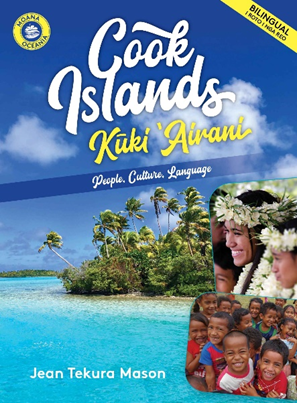Cook Islands: Kūki ‘Airani, Jean Tekura Mason,
Oratia, 2023, 48 pages, paperback, NZ$29.99, ISBN 978-1-99-004221-8
Sāmoa, Dahlia Malaeulu, Oratia, 2023, 48 pages,
paperback, NZ$29.99, ISBN 1-99-004222-5
These two lively books launch a new Moana Oceania series
from Oratia Books in Auckland. Both books are bi-lingual, with English on one
page and the appropriate Pacific islands language (in these two books, Cook
Islands Māori and Samoan) on the facing page. The subtitles for both books are
‘People, Culture, Language’ and the
authors have selected from these aspects well. The reading and interest level
of each book is aimed at 8 and up but the books carry a high level of appeal
for adults as well as children. The illustrations are colourful without being
touristy; many of them show ordinary people engaged in familiar activities or
special ceremonies. These books look not only at daily life in the islands
concerned but also shows how Cook Islanders and Samoans maintain their culture
and traditions at home and in New Zealand. So, these two books will be of great
value in the schools and homes of all three countries.
Cook Islands: Kūki ‘Airani, Jean Tekura Mason,
Oratia, 2023, 48 pages, paperback, NZ$29.99, ISBN 978-1-99-004221-8
‘
The Cook Islands’ way of life is one that includes
the fulfilment of duties to family and community, speaking the Maori language,
and living according to the culture and customs of the country.’ I wrote my
M.A. thesis on one small aspect of Cook Islands history and learned very
quickly that there are 15 islands and most have their own customs and culture. That
is why there are eight different dialects of Maori in the Cook Islands. Jean Tekura
Mason has a deep knowledge of the Cook Islands and has compressed a great deal
into this attractive introduction to her nation.
The book begins with the seven pillars of Cook Islands
culture: Ngakau aro’a (kindness), Kopu tangata (family), Marū (peacefulness),
Kauroro (respect to elders), Akakoromaki (patient fortitude), ‘Aka’aka (humility)
and ‘Irinaki’anga and akarongo (religious belief). The sections that follow
each show some of these in action, in village, church, school and sportsfield.

The text is bilingual with Cook Islands Maori (Rarotongan
dialect) on one page and English on the other. (There are useful pages on
language matters, including pronunciation guides and handy phrases.) Fact boxes
provide interesting snippets of information and statistics. The layout is
user-friendly with good headings. The history section is well presented
although the pictures need captions. Makea Ariki is mentioned in the text but
readers may not be aware that she also appears in three of the photos. Food and
clothing are important cultural elements, whether in the home islands or in New
Zealand, and these are well covered. Readers also learn about tatau (tattoo), tapa
cloth, weaving and tivaivai (quilts). Dancing, music and sport are all described,
with modern double-hull canoe voyaging linking us back to where we began with the
original settlements of the various islands.
Cook Islands: Kūki ‘Airani will be an important
book in encouraging interest in the Cook Islands and its lifeways among
young people, whether they live in the islands or New Zealand. Or
anywhere else in the world.
Trevor Agnew
Sāmoa, Dahlia Malaeulu, Moana Oceania series, Oratia,
2023, 48 pages, paperback, NZ$29.99, ISBN 1-99-004222-5
Over 70 years ago, two Samoan women visited our classroom
at Sawyers Bay School and talked to us about life in their home village. They
told us of their fale (houses) with their open walls. Our jaws dropped. It was
our first realisation of different ways of life in other countries.
In a way, this book carries on the work of those two
gracious women.
It introduces the Samoan culture, customs, traditions, language
and food, both to young people in other countries and to young Samoans living
overseas. The text is bilingual with English and Samoan pages facing each
other. Lively fact boxes offer information on everything from the ecologically-important
manumea (tooth-billed pigeon) to the types of siva (dance performances). There
is even a box for Samoan values: Fa’aaloalo (respect), Alofa (love), Tautua
(service) and Usita’i (discipline).
The book begins with the pillars of Fa’asāmoa – the
Samoan way of life – emphasising the importance of the family, the village, the
language, the church and food. There is a good summary of the sorry history of
New Zealand’s 20th Century relations with Samoa, and a useful introduction to
the geography and economy of the islands. A quick guide to the Samoan alphabet
and language includes useful words and a pronunciation guide.
The best part of Samoa concerns the Samoan people
and their activities, such as tatau (tattooing), singing, story-telling, mat
weaving and sport of all kinds, including fautasi (longboat racing) and the
joyous kilikiti. That’s an amazing amount to pack into 24 x 2 pages and Dahlia
Malaeulu – a great storyteller - has succeeded brilliantly. The selection of colour
illustrations is particularly good, again with an emphasis on people and their
activities.
Best of all there are several pictures of fale. Did you
know that they have no walls? The section on Samoan climate explains why not.
Trevor Agnew







No comments:
Post a Comment